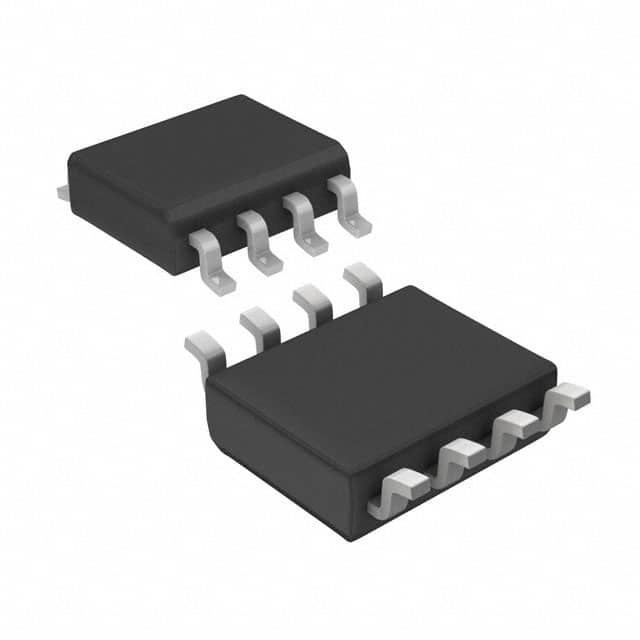STLVDS9637BDR
Product Overview
Category
STLVDS9637BDR belongs to the category of LVDS (Low Voltage Differential Signaling) transceivers.
Use
It is primarily used for high-speed data transmission in various applications, including automotive, industrial, and consumer electronics.
Characteristics
- LVDS technology: The STLVDS9637BDR utilizes LVDS technology, which enables high-speed data transmission with low power consumption.
- Robustness: It offers robust performance, making it suitable for demanding environments.
- High data rates: The transceiver supports high data rates, allowing for efficient data transfer.
- Noise immunity: It provides excellent noise immunity, ensuring reliable signal transmission even in noisy environments.
Package
The STLVDS9637BDR comes in a small outline package (SOIC), which facilitates easy integration into electronic circuits.
Essence
The essence of STLVDS9637BDR lies in its ability to transmit high-speed data reliably and efficiently using LVDS technology.
Packaging/Quantity
This product is typically packaged in reels or tubes, with a quantity of 2500 units per reel/tube.
Specifications
- Supply voltage: 3.3V
- Operating temperature range: -40°C to +85°C
- Data rate: Up to 400 Mbps
- Number of channels: 4
- Input/output voltage range: 0V to 3.3V
- ESD protection: ±8kV (HBM)
Detailed Pin Configuration
The STLVDS9637BDR has a total of 16 pins, which are assigned specific functions as follows:
- VCC
- GND
- RXP
- RXN
- RXD0
- RXD1
- RXD2
- RXD3
- TXP
- TXN
- TXD0
- TXD1
- TXD2
- TXD3
- DE
- RE
Functional Features
- Bi-directional data transmission: The transceiver allows for simultaneous transmission and reception of data.
- Differential signaling: It utilizes differential signaling to minimize noise interference and improve signal integrity.
- Built-in termination resistors: The STLVDS9637BDR includes built-in termination resistors, simplifying the design and reducing external component count.
- Power-saving mode: It features a power-saving mode that reduces power consumption when the device is not actively transmitting or receiving data.
Advantages and Disadvantages
Advantages
- High-speed data transmission capability
- Low power consumption
- Robust performance in demanding environments
- Excellent noise immunity
- Integrated termination resistors for simplified design
Disadvantages
- Limited number of channels (4 channels)
Working Principles
The STLVDS9637BDR operates based on LVDS technology, which uses a differential signaling scheme. In this scheme, data is transmitted as voltage differences between two complementary signals, known as the positive (P) and negative (N) signals. This differential signaling helps reduce electromagnetic interference and improves noise immunity.
The transceiver receives the differential input signals and converts them into single-ended signals for further processing. Similarly, it converts single-ended output signals into differential signals for transmission. The integrated termination resistors ensure impedance matching and signal integrity.
Detailed Application Field Plans
The STLVDS9637BDR finds applications in various fields, including:
- Automotive: Used in automotive infotainment systems, driver assistance systems, and communication modules.
- Industrial: Employed in industrial automation, control systems, and high-speed data acquisition.
- Consumer electronics: Utilized in high-definition displays, audio/video equipment, and gaming consoles.
Detailed and Complete Alternative Models
- SN65LVDS9637BDR: A similar LVDS transceiver with comparable specifications and features.
- DS90LV019BDR: Another LVDS transceiver offering high-speed data transmission and noise immunity.
- MAX9124ESE+: An alternative LVDS transceiver with integrated ESD protection and low power consumption.
These alternative models can be considered based on specific application requirements and design considerations.
Word count: 511 words
Senaraikan 10 soalan dan jawapan biasa yang berkaitan dengan aplikasi STLVDS9637BDR dalam penyelesaian teknikal
Sure! Here are 10 common questions and answers related to the application of STLVDS9637BDR in technical solutions:
Question: What is the STLVDS9637BDR?
Answer: The STLVDS9637BDR is a high-speed differential line driver and receiver designed for applications that require high data rates and low power consumption.Question: What is the maximum data rate supported by the STLVDS9637BDR?
Answer: The STLVDS9637BDR supports data rates up to 400 Mbps.Question: Can the STLVDS9637BDR be used in automotive applications?
Answer: Yes, the STLVDS9637BDR is suitable for automotive applications as it operates over a wide temperature range and meets automotive industry standards.Question: How many differential channels does the STLVDS9637BDR have?
Answer: The STLVDS9637BDR has three differential channels, making it suitable for applications that require multiple data lines.Question: What is the supply voltage range for the STLVDS9637BDR?
Answer: The STLVDS9637BDR operates with a supply voltage range of 3.0V to 3.6V.Question: Can the STLVDS9637BDR be used in point-to-point communication systems?
Answer: Yes, the STLVDS9637BDR can be used in point-to-point communication systems where high-speed data transmission is required.Question: Does the STLVDS9637BDR support hot-plugging?
Answer: Yes, the STLVDS9637BDR supports hot-plugging, allowing for easy connection and disconnection of devices without disrupting the system.Question: What is the power consumption of the STLVDS9637BDR?
Answer: The STLVDS9637BDR has low power consumption, making it suitable for battery-powered applications.Question: Can the STLVDS9637BDR be used in industrial automation systems?
Answer: Yes, the STLVDS9637BDR is suitable for industrial automation systems as it can operate in harsh environments and has high noise immunity.Question: Does the STLVDS9637BDR require external termination resistors?
Answer: No, the STLVDS9637BDR has internal termination resistors, simplifying the design and reducing component count.
Please note that these answers are general and may vary depending on specific application requirements. It is always recommended to refer to the datasheet and consult with technical experts for accurate information.


